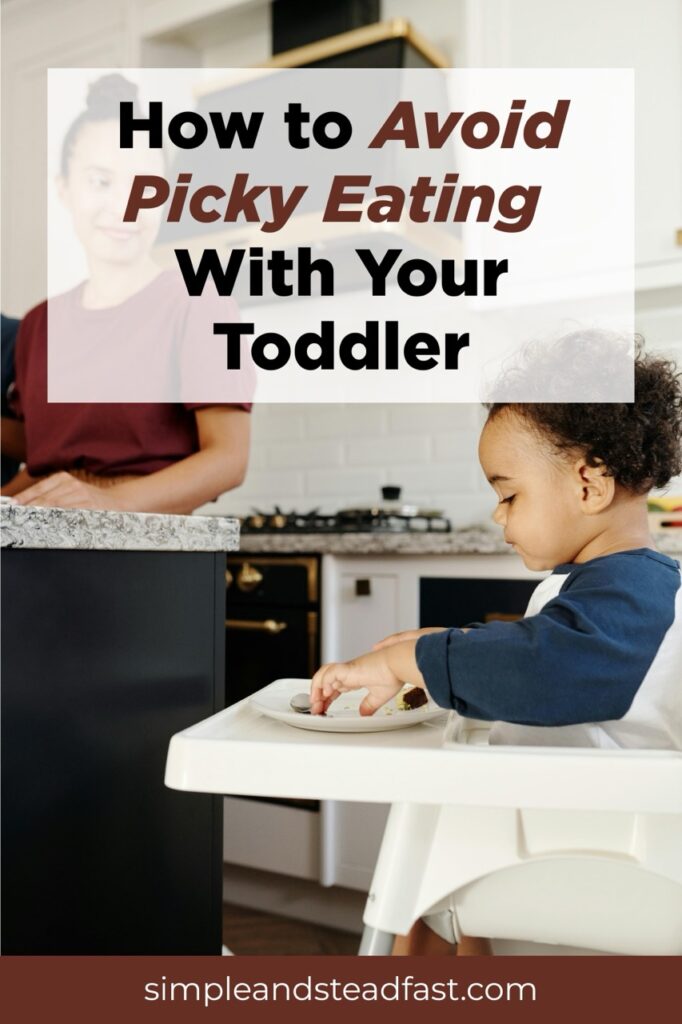Getting your toddler to eat can be a challenge. They’re starting to learn what foods they like and don’t like, they don’t want to sit still for a meal, and mealtimes can be a huge mess. Sometimes your well-prepared, healthy meal ends up on the floor—or smooshed between their cute little toes.
I’ve been pretty lucky when it comes to my daughter’s eating. From the time she was a baby and we started offering solids, she was always interested in food and often preferred it over breast milk.
Even though I believe her personality and temperament play a big role in her being such a “good” eater, there are a few things I started doing early on that I think helped encourage her to eat the meals I prepared.
Before we get into it, remember that I am not a toddler eating expert! This is just my experience with my child and what worked for us. No baby or toddler is the same—some are just naturally more picky than others. Some things that worked for me, may not work for you and that’s okay. I’m sure my next child will make me second-guess writing this post!
But here’s what I did to help avoid picky eating with my toddler:
The 100 Foods Before One Approach
I first heard of this idea on social media. It’s pretty self-explanatory—the goal is for your baby to try 100 different foods before their first birthday. If you’re like us and start solids around 6 months, that gives you about 6 months to try 100 foods.
It sounds like a lot and can seem overwhelming, but there are truly so many things they can try for the first time. Here are just some of the foods my daughter had:
- Avocado
- Banana
- Strawberries
- Blueberries
- Kiwis
- Peaches
- Eggs
- Green beans
- Yogurt
- Sweet potato
- Spinach
- Broccoli
- Spaghetti
- Pickles
- Ground beef
And the list goes on! If you need inspiration, just wander through the produce section at the grocery store and see how many options are available.
To be honest, we didn’t quite make it to 100 foods by her first birthday—we made it to 87—but the real goal is to keep pushing yourself to introduce new foods. As someone who tends to stick to routines with meals, I knew this would help hold me accountable to offering variety. I really do believe this made a big difference in why she’s so open to different foods now!
Baby-Led Weaning
When I was getting ready to introduce solids, I felt totally overwhelmed. I didn’t know the best way to go about it—whether I should do purées, baby-led weaning, a mix of both, or something else entirely. I finally decided to go the baby-led weaning route, but the whole concept felt intimidating.
That’s when I found an Instagram account called Solid Starts (@solidstarts). They share so many helpful tips and tutorials, and eventually I bought their Starting Solids course. It answered so many of my questions and made me feel much more confident with baby-led weaning.
Another great resource was their Solid Starts app. You can type in any food you’re planning to serve your baby and get information on how to serve it safely, what age it’s appropriate for, its nutritional value, and more. I followed the app to a T during those first few months. They offer a paid version with extra features, but I just used the free one—and highly recommend it!
There’s a lot of research behind the benefits of baby-led weaning, including that it may help prevent picky eating. I think that’s because babies get exposed to a variety of textures and start to enjoy eating the same things you are.
Which brings me to my next point…
Feed Your Toddler the Same Thing You’re Eating
Since my daughter first started solids, I’ve always served her what I was eating—modified a bit at first, of course. I think this is such a helpful habit to build because it teaches your child that when we eat as a family, we all eat what’s served.
I still do this now that she’s a toddler. Sure, there are nights when she doesn’t eat much of her dinner or skips the broccoli—but that’s okay with me. It might sound a little harsh, but I don’t believe she’ll starve from missing one meal. If kids are hungry, they’ll eat. It’s just biology.
If your child refuses their meal and you constantly offer something else, they’ll quickly learn they can get whatever food they want. Don’t get me wrong—there have definitely been times I’ve caved and made her something I knew she’d eat. But doing that too often sends the message that they have the power to demand a different meal whenever they don’t like what’s on their plate.
Of course, some parents are okay with offering alternatives—and that’s totally fine! But for me, I put a lot of time and effort into planning and cooking meals during the week. It’s important to me to teach my kids that we eat what’s served, even if it’s not our favorite.
Let Your Baby Self-Feed From The Start
Another thing that can help your child avoid picky eating is letting them self-feed from the time you start solids. Yes, it gets messy, but it’s all part of the learning process!
Some of the benefits of letting your baby feed themselves include:
- A better understanding of what the food feels like, so they know what to expect when it goes into their mouth
- Greater awareness of their own fullness cues
- A reduced risk of choking
Plus, they usually find it really fun!
Another reason I think self-feeding is so important is that it helps us as parents not to hover. If we make eating feel like a big deal, that pressure can actually turn kids off from food—especially as toddlers (if you know, you know).
Eating should just be a normal, no-pressure part of life. Trying to force them to eat more of something or praising every single bite can actually backfire and lead to pickier eating later on. Let your baby or toddler eat at their own pace and stop when they’re full. This builds great eating habits as they grow.
Keep Offering Foods Your Toddler Refuses
Sometimes, without realizing it, we reinforce our child’s picky eating. You might think, “He doesn’t like green beans, so I won’t put any on his plate.” And honestly, I get it—you don’t want to waste food or have it thrown on the floor.
But there’s value in continuing to put those “rejected” foods on their plate.
When I do this, I always make sure to include 1–2 other foods in the meal that I know my daughter enjoys. That way, there’s no pressure to eat the food she’s still unsure about. I’ll even remind her that it’s okay to leave something on her plate if she doesn’t want it.
They might not touch the green beans the first 20 times—but one day, they just might try them again and decide they love them!
That happened recently with bananas in our house. From the very beginning, my daughter wasn’t a fan. We thought it was the texture because she loved banana muffins and other banana-flavored things, but if we gave her an actual banana, she’d spit it out right away.
Still, we kept offering a banana every once in a while to see if she’d change her mind. And a few weeks ago… she did! She tried it, loved it, and now we’re going through bananas like crazy 😂
So if you need the reminder—just keep trying. You never know what could happen!
These are just a few of the things I did that I believe helped my daughter become a “good” eater. That said, I fully acknowledge that she’s also naturally open to trying new foods. I know some moms whose babies just aren’t interested in solids at first, no matter what they try.
For us, 100 Foods Before One worked great because my daughter was curious and willing to try new things. That might not be the case for you—and that’s okay! Your child will still grow, thrive, and feel so loved, picky or not.
Every child is different, and we’re all just doing our best. And remember: every mom has something they’re struggling with and wishes they could change. Even though my daughter eats well, she definitely doesn’t sleep well. You win some, you lose some—that’s just life with a toddler!
Good luck, mamas! I’d love to hear your tips for helping with picky eating—leave a comment below!






Leave a Reply